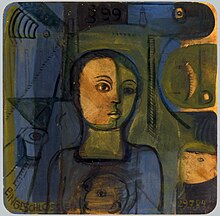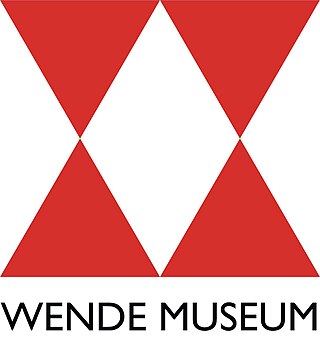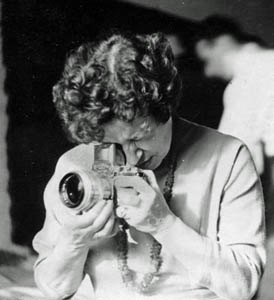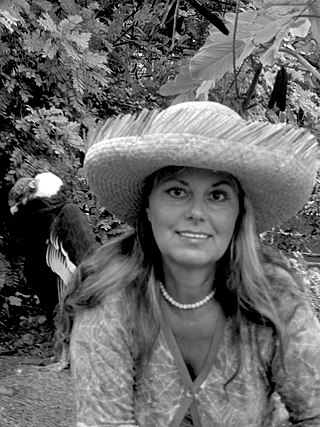Annemirl Bauer | |
|---|---|
 | |
| Born | 10 April 1939 Jena, Germany |
| Died | 23 August 1989 (aged 50) Berlin, Germany |
| Nationality | German |
| Known for | Painting |
| Website | annemirlbauer |

Annemirl Bauer (1939-1989) was an East German painter. [1]
Annemirl Bauer | |
|---|---|
 | |
| Born | 10 April 1939 Jena, Germany |
| Died | 23 August 1989 (aged 50) Berlin, Germany |
| Nationality | German |
| Known for | Painting |
| Website | annemirlbauer |

Annemirl Bauer (1939-1989) was an East German painter. [1]
Bauer was born in Jena on 10 April 1939. She studied at the Akademie der Bildenden Künste (Dresden). [2] She was a prolific artist, and also a vocal critic of the GDR on the issue of conscription of women and restriction of travel into West Germany. Her political stance resulted in her expulsion from the East German Verband Bildender Künstler (Association of Visual Artists). [3]
Bauer died in Berlin on 23 August 1989. [2]
In 2010 a park in Berlin, Annemirl-Bauer-Platz, was named in her honor. [4]
In 2019 her work was included in the exhibit The Medea Insurrection: Radical Women Artists Behind the Iron Curtain at Wende Museum in Culver City, California. [5]

The Iron Curtain is a political metaphor used to describe the political boundary dividing Europe into two separate areas from the end of World War II in 1945 until the end of the Cold War in 1991. The term symbolizes the efforts by the Soviet Union (USSR) to block itself and its satellite states from open contact with the West, its allies and neutral states. On the east side of the Iron Curtain were the countries that were connected to or influenced by the Soviet Union, while on the west side were the countries that were NATO members, or connected to or influenced by the United States; or nominally neutral. Separate international economic and military alliances were developed on each side of the Iron Curtain. It later became a term for the 7,000-kilometre-long (4,300 mi) physical barrier of fences, walls, minefields, and watchtowers that divided the "east" and "west". The Berlin Wall was also part of this physical barrier.

Sibylle Bergemann was a German photographer. In 1990, she co-founded the Ostkreuz photographers agency. She is remembered for documenting developments in East Berlin during the Communist era and for her international assignments for Stern and later for Geo.

The Wende Museum is an art museum, historical archive of the Cold War, and center for creative community engagement in Culver City, California.

Natalia Lach-Lachowicz was a Polish artist who worked with paint, photography, drawing, performance, and video art. Sean O'Hagan, writing in The Guardian in 2017, described her as "a neglected early-1970s Polish-born pioneer of feminist avant garde image making".

Magdalena Jetelová is a Czech installation artist and land artist, who has achieved international acclaim. Known mainly for her environmental installation works, Jetelová combines light, architecture, photography, sculpture, and installation to explore the relationship between humans, objects, and space. Her work has been exhibited in various prominent galleries internationally such as Museu d'Art Contemporani de Barcelona, Tate Gallery London, Museum of Modern Art, 21er Haus, and the Martin-Gropius-Bau. Her work is also in the collection of Hirschorn Museum, the Centre Pompidou, and the Museum Ludwig.
Tina Bara is a German photographer who began her career in the German Democratic Republic Her work was featured in several exhibitions at key galleries and museums, including the Galerie Eigen + Art, Leipzig and the Kunsthalle Erfurt. In MutualArt’s artist press archive, Tina Bara is featured in Interference, a piece from the Revista Arta in 2020.

Erika Stürmer-Alex is a German artist whose works include wall paintings, panel paintings, printed graphics, collage sculptures, polyester sculptures and installations.

Zofia Rydet was a Polish photographer, best known for her project "Sociological Record", which aimed to document every household in Poland. She began working on "Sociological Record" in 1978 at the age of 67, and took nearly 20,000 pictures until her death in 1997. Many of the pictures remain undeveloped. The photographs are predominantly portraits of children, men, women, couples, families and the elderly amidst their belongings. Rydet tended to photograph her subjects straight-on, using a wide-angle lens and a flash.

Angelika Barbe is a German biologist who became a politician.

Evelyn Richter was a German art photographer known primarily for social documentary photography work in East Germany. She is notable for her black & white photography in which she documented working-class life, and which often showed influences of Dadaism and futurism. Her photography is focused on people in everyday life, including children, workers, artists and musicians.
Karla Woisnitza is a German artist.

Alena Kučerová is a Czech printmaker.
Ana Lupaș is a Romanian installation artist, textile artist, and photographer. She studied at the Institute of Fine and Decorative Art in Cluj-Napoca. She first exhibited her art in 1965 at the National Exhibition for Decorative Arts, Bucharest. In 2016 her work was exhibited at the Museion, Museo d'Arte Moderna e Contemporanea in Bolzano, Italy. The same year the Tate purchased her large scale work "The Solemn Process 1964–2008 ". The work took five decades to complete and was first shown in 2008 at Taxispalais in Innsbruck. The Solemn Process included mixed media of, straw, metal and photographs, and used local workers to help build and pose with some of the sculptures, which were eventually included in the art piece itself. As years went by, some sculptures had to be re-built into longer lasting materials. Lupaș wanted to mimic the harvesting process of Romania, as well as illustrating that art itself, can be an evolving process.

Zorka Ságlová (1943–2003) was a Czech textile artist, painter, and performance artist.

Gundula Schulze Eldowy is a German photographer. In addition to her photographic and film work, she has created stories, poems, essays, sound collages and songs.

Angela Hampel is a German painter, graphic artist, and installation artist best known for her Neo-expressive prints and paintings of strong female figures from mythology and the Bible.
Hanne Wandtke is a contemporary dancer and choreographer. She was director of the Palucca School of Dance, Dresden.
The Erfurt Women Artists' Group was founded in 1983 by Gabriele Stötzer. It was a group of women artists in Erfurt, East Germany. They met weekly in various houses around Erfurt. They created films and fashion as well as ceramics, photographs and paintings. The group staged performances, fashion shows, and concerts.

Else Gabriel is a German performance artist and educator.
The Wochenpost was an East German weekly. It was founded in 1953, and circulation peaked at over one million copies per issue from 1971 to the German reunification. The academic Deirdre Byrnes writes that the paper was "one of the most influential" publications in East Germany. Its highest circulation was around 1.2 million copies, making the paper the most popular weekly in East Germany. It was considered a paper for intellectuals. The paper continued to be published after German reunification until it ceased publication in late December 1996.